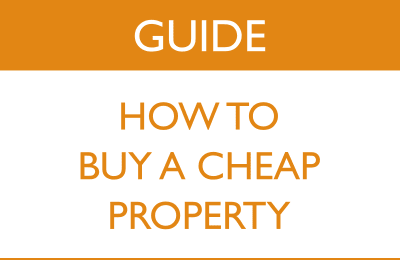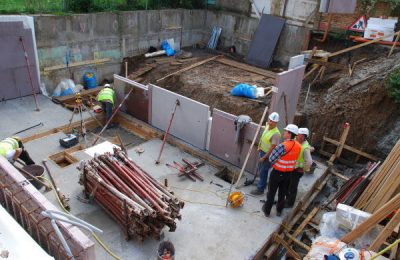House prices have been steadily rising for the last few years, and even with the recent slowdown because of factors like Brexit, buying a house is still out of reach for many in the UK, especially in the capital. Buying a cheap house and London are rarely found in the same sentence!
There are a few ways of buying a cheap(er) house though, even in the Big Smoke. Here’s a few ideas of how to do it.
Buy a derelict property and do it up
The concept of flipping houses has been around for a long time. But even if you plan on living in the home, the process is pretty much the same: 1. Buy a wreck for a discount. 2. Fix it up. 3. Move into your cheap new home!

Advantages
The obvious advantage of buying a doer upper is that it’s possible to find a flat or house for a much cheaper price than a ready to live in modernised and renovated property would be. If you choose well, (and are lucky) you might be able to fix up the place with minimal work and money to put in.
If you do a lot of the work yourself, you can save even more money on house renovation costs, and many people have added tens of thousands of pounds to the value of their property this way.
On top of the reduction in the price, you will also pay less stamp duty which could end up being a saving of thousands of pounds.
And finally, when it comes to selling, you may have added value and will benefit from tax-free capital gain – i.e. profit!
Another advantage of doing up a property is that you get to choose how you want to live – do you want an open plan living room, do you want to squeeze an extra bedroom in, or do you want to kit your home out with the latest wired-in sound system? When you gut a property and then start fitting it out, you choose what goes in it. If you’re buying an existing home, you have to put up with the choices of the previous owner – whether that’s a mauve coloured bath or butterflies on the tiles.
Disadvantages
Of course, there are disadvantages to buying a cheap run down house. One disadvantage is the uncertainty of what you might find once you start ripping out walls and floors. If there is any real structural damage to the property, it could cost you a lot more to fix than you had originally budgeted for.
If there’s a lot of work to be done to the property, there is also the issue of time that you will have to spend. With a simple fit-out, all the work should be done in a few months, and the property will be ready to move in to, but if you find some real issues, and you’re tight on money, renovations could extend from months to years in some cases.
Lastly, if you have bought a completely unrenovated property, you might not be able to live at the property until the major work is finished, so you will have to consider where you might live while work is being done, and whether or not that living situation can be extended if the build starts to become complicated.
You might find yourself paying for rent and a mortgage at the same time, so that’s definitely something to keep in mind.
Buy a repossessed property
A repossessed property has generally been repossessed by the lender from the previous owner who has defaulted on their loan or mortgage.
Advantage
Repossessed properties are generally priced lower than other homes on the market, because the property has , and they will usually want to sell it off quickly to recoup the money lost.
Disadvantage
These types of properties can present the same types of issues as the ones above, and are often sold at auction. You can also find them listed by some specialist platforms such as Repo List and Property to Renovate. It might also be worth contacting local agents, who may have repossessed properties on their books that they have not advertised.
The other thing to bear in mind is how you actually buy a renovation property. If a house is completely dilapidated, then you may not be able to get a mortgage. If that’s the case, you will have to consider getting bridging finance or putting in cash.

Buying at auction can make this a harder route for you due to the timetables involved. Bridging finance is quick, but very expensive. They will also generally lend you money on a lower loan to value ratio than a typical mortgage. This means you will need access to more cash.
For all the reasons above, you will probably be thinking that buying at auction sounds like a lot of risk and hassle. You’re right. But it’s that risk and hassle than creates the discount to the ‘open market value’. The key piece of advice is:
Caveat Emptor (Buyer beware).
Buy a smaller home
Another way to get a cheap property, is to simply buy a smaller home than your ideal home that you’ve always dreamed of. It sounds pretty obvious, but generally, although not always, smaller homes cost less money than larger homes.
Advantage
In your area, there will be an approximate rate per square foot. In London, that rate varies from as low as £300 per square foot (psf) to £3000 psf. This is the difference between living in Mayfair or Knightsbridge and Leyton or Plumstead.
Naturally, this means that if you go for a smaller property, even in an expensive area, you will be paying less for your home. If you buy a 1000 sq ft home (which equates to a small 3 bed house or a generous 3 bed flat) in an area of £300 psf then you pay £300,000. If the area is £3,000 psf then you will be looking at an eye-watering £3m for the same sized home!
Disadvantage
The obvious disadvantage is that if you want to stay in an area with a really high rate per sq ft, then the property you might be able to afford could be very small indeed, and might not meet your needs. So what are your choices?
You have a couple of options. Companies like Pocket Living have built some micro flats, designed to use every square inch of space and to be just as functional as a larger home that is wasteful of space. Many of these types of new developments also incorporate communal indoor as well as outdoor space, increasing the sense of community.
We haven’t yet seen it in the UK on a large scale, but in the US there is a huge movement for what they call ‘tiny houses’.
Of course, you could also buy a small property with potential to expand. So, you could do the obvious things like a loft extension, a side extension. Or you could do the less common route of building an office in the garden, expanding into the basement, or building a new home in the garden.
Buy an unfashionable property
Sometimes properties go out of fashion. Most of us love the Victorian or Georgian period properties. They are considered to be good stock and will always sell as lots of people love them.
Advantage
If you want a cheaper property, unmodernised properties from other periods – eg more modern houses from the 30’s, 40’s, 50’s, 60’s or 70’s, can come with a bigger discount than Victorian or Georgian stock. Some of these properties are not considered to be particularly pretty but can be well built. Ex-council houses tend to sell at a discount too because they can come with a bit of a stigma.

Disadvantage
Be careful that you might not be able to get a mortgage, as some of these homes were built with different building construction types and lenders may be a bit harder to find.
Bear in mind, too, that if you bought an unfashionable home cheaply, it could mean that when you come to sell it, you may have to sell it cheaply too. It may have gone up in value, but maybe less than surrounding properties.
That’s not generally a problem if you are intending to stay there for a long time, but if you are using it as a stepping stone to get on the housing ladder, then make sure you think carefully about what you will need to step up to the next rung.
The ways to get around this are either to buy in an area that is going up in value (generally through gentrification) or buy adding value.
Build your own home or buy a shell
At Rare Space, we specialise in selling custom built homes. Some custom build homes are sold as plots where you can build your dream home (within some constraints). Some are sold as shells, where the developer has built the outside, and you get to create the inside, which is basically self-build made easy.
Advantage
These are homes where you get both choice and value. Because it is a new build, you bypass a lot of the issues and risk of buying a wreck, or a house at auction.
 Construction at Zog House
Construction at Zog House
New build shells are built to be airtight and watertight, and come with a 10 year guarantee so you know you won’t have any structural issues like damp, mould, or rot to deal with. You will simply have a brand new blank canvas which is all ready for you to design your dream home around, reducing a lot of risk and uncertainty.
Because a shell is already essentially a house stripped back to the core, you’re not constrained to the layout and design of the previous home (which could cost a considerable amount to change). You have the freedom to lay out your home to suit your own unique needs, and choose the spec and fittings that you like for your home.
Buying a shell can also save you money on taxes. Since stamp duty is calculated on the price paid for the home, buying a shell (which costs less than a full fitted out home) means that you could have stamp duty savings of tens of thousands of pounds.
You would also be able to reclaim VAT on all building work and fittings bought for the home, as it is still categorised as a new build (which is 0% VAT). That means on a typical £5,000 Ikea kitchen, you’ll get it for £4,000, and if you pick one up in the sale, you still get the VAT back! If you decide to do some or all the work yourself, or can source cheaper materials, then there are even more savings to be had.
Disadvantage
If you are looking for a home to move into straight away, then custom build might not be for you. The finishing of a layout can take months, depending on whether or not you’re doing the work yourself, you’re hiring contractors, or the project going smoothly.
However, we still believe that to get the best value for your money whilst buying a home that suits you perfectly, there’s no better route than custom build.



